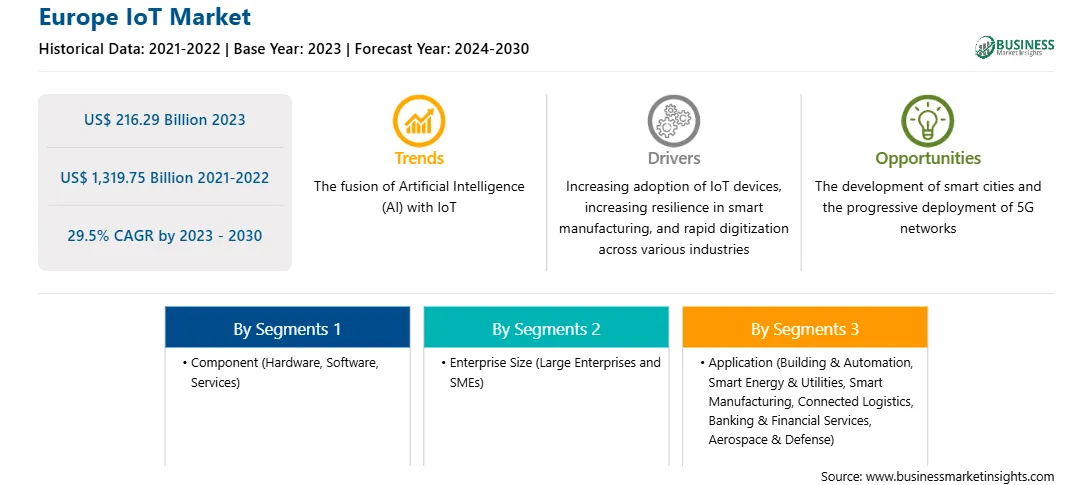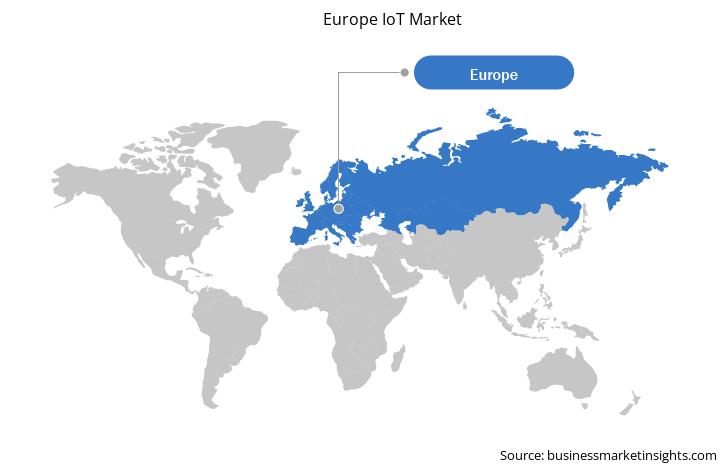In the past few years, 2G, 3G, and 4G communication technologies were mainly developed for mobile broadband and personal communication services and have proven extremely proficient in meeting the demands for IoT. However, the emergence of 5G has encouraged dedicated capabilities tailored for numerous IoT applications. There is an increase in investment in 5G infrastructure across developed and developing countries as 5G enables stable, faster, and secure connectivity, helping advance IoT applications for self-driving vehicles, smart grids for renewable energy, and AI-enabled robots on factory floors. According to Qualcomm, an American multinational corporation, the global 5G value chain is anticipated to reach US$ 3.5 trillion by 2035, which is greater than the mobile value chain as of 2021. Therefore, this growth of the 5G value chain is a major contributor to the expansion and deployment of the 5G network. Moreover, according to the report published by GSM Association, the number of IoT-connected devices is expected to reach 25.2 billion by 2025. The integration of 5G network technology with IoT devices is projected to enable seamless and reliable connection. Due to the growth of the critical communication services industry, there is a rapid rollout of the 5G network by various telecom providers, which is expected to create lucrative opportunities for IoT software players in the coming years.
Europe dominated the IoT market with the largest share in 2022. The demand for IoT solutions is increasing across Europe, especially in countries such as Germany, the UK, and France. A surge in inclination toward cloud-based IoT software, the need for improved supply chain and customer relationship management operations, and advancements in industrial-grade digital products are the major factors contributing to the growth of the IoT market across the region. The manufacturing, healthcare, and BFSI sectors are the key contributors to the IoT market in Europe.
Governments of European countries are taking various initiatives to bolster the adoption of IoT and edge computing. In March 2021, the European Commission conducted a Fireside Chat workshop to mobilize and connect expert stakeholders from the agriculture, automotive, aerospace, construction machinery, home, and industrial automation verticals, among others. The aim of this workshop was to design a strategy for the future progress of IoT and edge computing in Europe with a market window over five years. In addition, the European Union (EU) hosts various funding programs for next-generation IoT and edge computing. For example, through Horizon Europe, the EU will contribute more than US$ 169.86 million (EUR 150 million) in research and innovation (R&I) under its 2021 “World Leading Data and Computing Technologies: From Cloud to Edge to IoT for European Data.’’ The program will support the development and deployment of next-generation computing components, systems, and platforms. Thus, such initiatives by the EU would fuel the growth of the Europe IoT market in the coming years.
Strategic insights for the Europe IoT provides data-driven analysis of the industry landscape, including current trends, key players, and regional nuances. These insights offer actionable recommendations, enabling readers to differentiate themselves from competitors by identifying untapped segments or developing unique value propositions. Leveraging data analytics, these insights help industry players anticipate the market shifts, whether investors, manufacturers, or other stakeholders. A future-oriented perspective is essential, helping stakeholders anticipate market shifts and position themselves for long-term success in this dynamic region. Ultimately, effective strategic insights empower readers to make informed decisions that drive profitability and achieve their business objectives within the market. The geographic scope of the Europe IoT refers to the specific areas in which a business operates and competes. Understanding local distinctions, such as diverse consumer preferences (e.g., demand for specific plug types or battery backup durations), varying economic conditions, and regulatory environments, is crucial for tailoring strategies to specific markets. Businesses can expand their reach by identifying underserved areas or adapting their offerings to meet local demands. A clear market focus allows for more effective resource allocation, targeted marketing campaigns, and better positioning against local competitors, ultimately driving growth in those targeted areas.Europe IoT Strategic Insights

Europe IoT Report Scope
Report Attribute
Details
Market size in 2023
US$ 216.29 Billion
Market Size by 2030
US$ 1,319.75 Billion
CAGR (2023 - 2030) 29.5%
Historical Data
2021-2022
Forecast period
2024-2030
Segments Covered
By Component
By Enterprise Size
By Application
Regions and Countries Covered
Europe
Market leaders and key company profiles
Europe IoT Regional Insights

Europe IoT Market Segmentation
The Europe IoT market is segmented based on component, enterprise size, application, and country. Based on component, the Europe IoT market is segmented into hardware, software, and services. The hardware segment held the largest market share in 2023. Furthermore, software is segmented into device management, application management, data management, and network management.
Based on enterprise size, the Europe IoT market is bifurcated into large enterprises and SMEs. The large enterprises segment held a larger market share in 2023.
Based on application, the Europe IoT market is segmented into building & automation, smart energy & utilities, smart manufacturing, connected logistics, banking & financial services, aerospace & defense, and others. The smart manufacturing segment held the largest market share in 2023.
Based on country, the Europe IoT market is segmented into Germany, France, Italy, the UK, Russia, Sweden, Belgium, Netherlands, Switzerland, and the Rest of Europe. Germany dominated the Europe IoT market share in 2023.
Amazon Web Services Inc.; Cisco Systems Inc.; Google LLC; Software AG; International Business Machines Corp; Intel Corp; Microsoft Corp; Oracle Corp; Siemens AG; and SAP SE are the leading companies operating in the Europe IoT market.
The Europe IoT Market is valued at US$ 216.29 Billion in 2023, it is projected to reach US$ 1,319.75 Billion by 2030.
As per our report Europe IoT Market, the market size is valued at US$ 216.29 Billion in 2023, projecting it to reach US$ 1,319.75 Billion by 2030. This translates to a CAGR of approximately 29.5% during the forecast period.
The Europe IoT Market report typically cover these key segments-
The historic period, base year, and forecast period can vary slightly depending on the specific market research report. However, for the Europe IoT Market report:
The Europe IoT Market is populated by several key players, each contributing to its growth and innovation. Some of the major players include:
The Europe IoT Market report is valuable for diverse stakeholders, including:
Essentially, anyone involved in or considering involvement in the Europe IoT Market value chain can benefit from the information contained in a comprehensive market report.